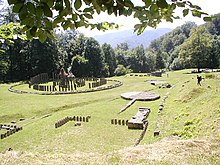Orăştie Mountains
| Dacian Fortresses of the Orăștie Mountains | |
|---|---|
| Name as inscribed on the World Heritage List | |

|
|
| Location | Romania |
| Type | Cultural |
| Criteria | ii, iii, iv |
| Reference | 906 |
| UNESCO region | Europe and North America |
| Inscription history | |
| Inscription | 1999 (23rd Session) |
Built in murus dacicus style, the six Dacian Fortresses of the Orăștie Mountains, in Romania, were created in the 1st centuries BC and AD as protection against Roman conquest, and played an important role during the Roman-Dacian wars.
Their extensive and well-preserved remains present a picture of a vigorous and innovative ancient civilization. Today, treasure-hunters sometimes search the area, as Romania lacks legislation in this domain.
The six fortresses - Sarmizegetusa Regia, Costeşti-Cetăţuie, Costeşti-Blidaru, Piatra Roşie, Bănița and Căpâlna - that formed the defensive system of Decebalus were designated as a UNESCO World Heritage Site in 1999. All the sites are in Hunedoara County, except for Căpâlna, which is in Alba County.
The town of Sarmizegetusa Regia was the capital and major fortress of the Dacian kingdom, probably built in the mid first century BCE. It consisted of perimeter walls and fortifications, a sacred precinct, and a settlement area primarily for nobles and supporting servants. It was located at the top of a 1200-meter hill with excellent visibility of the surrounding lands. The sacred precinct was on the east side of the town, with a prominent plaza and circular shrines. There were two settlement areas one on the east side and a larger one on the west. In addition to dwellings they included workshops, storage buildings, and agricultural processing areas. Notable for the time is a distribution system for drinking water that used ceramic pipes.
...
Wikipedia
